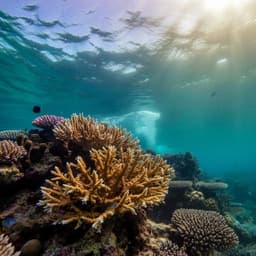
Earth Sciences
Establishing flood thresholds for sea level rise impact communication
S. Mahmoudi, H. Moftakhari, et al.
Discover how a groundbreaking high tide flood thresholding system harnesses machine learning to estimate sea level rise and HTF thresholds along US coastlines. This innovative research, conducted by Sadaf Mahmoudi, Hamed Moftakhari, David F. Muñoz, William Sweet, and Hamid Moradkhani, aims to enhance community awareness and adaptation planning efforts for coastal areas.
Playback language: English
Introduction
High tide flooding (HTF), also known as sunny day flooding or nuisance flooding, is a type of minor flooding caused by elevated coastal sea levels. While individual HTF events may cause minimal damage, their increasing frequency and duration due to sea level rise (SLR) pose significant long-term challenges. Cumulative impacts on coastal communities include infrastructure degradation, business interruptions, and public health concerns. Previous studies using NOAA tide gauge data have shown a clear increase in HTF events along US coastlines, primarily attributed to SLR. The need for effective adaptation strategies is crucial, but developing these strategies requires accurate local-scale estimations of SLR and HTF thresholds. Current methods rely heavily on point-based tide gauge measurements, which are sparse and unevenly distributed, particularly along the US coastline. This lack of data hinders effective risk communication and planning in many coastal communities. Existing approaches, such as linear relationships between thresholds and greater tidal ranges, suffer limitations due to their inability to capture the spatial variability in HTF thresholds. This study aims to develop a novel approach using machine learning (ML) to provide spatially distributed estimates of SLR rates and HTF thresholds at a much finer resolution, enabling improved communication of SLR risks to vulnerable communities.
Literature Review
Existing research demonstrates the increasing frequency and impact of high tide flooding (HTF) along coastlines globally, largely attributed to sea-level rise (SLR). Studies utilizing NOAA tide gauge data have shown a clear upward trend in HTF events in the United States. However, the spatial distribution of tide gauges is uneven, leading to data scarcity in many coastal areas. This limitation hampers accurate assessment and prediction of HTF at a local level, hindering effective communication of risks and planning of mitigation strategies. Previous attempts to establish HTF thresholds have relied on linear regression models, often using a single predictor variable (greater tidal range). These methods are often too simplistic, failing to capture the complex interplay of factors influencing HTF thresholds. The need for a more sophisticated, spatially explicit approach that considers multiple factors is evident.
Methodology
This study uses machine learning (ML) algorithms to estimate spatially distributed sea level rise (SLR) rates and high tide flood (HTF) thresholds along the US coastline at a 10km resolution. The methodology involves three main steps: 1) Clustering: K-means clustering was used to group the coastal areas into three distinct regions based on shared characteristics of the input features related to HTF thresholds. The optimal number of clusters was determined using the elbow method. Three clusters were identified: the West Coast, Gulf and Southeast Coasts, and the Northeast Coast. This regionalization accounts for variations in coastal dynamics. 2) SLR Algorithm Development: A Random Forest (RF) regression model was trained and validated using existing NOAA gauge data to predict SLR rates at ungauged locations. Feature engineering and hyperparameter tuning using randomized search were crucial steps in developing the RF model for each region and climate scenario. Various factors including global ocean heat content, ocean circulation data, and vertical land motion were used as input features. The importance of each feature was determined for each region. 3) HTF Threshold Algorithm Development: A similar RF regression model was developed to estimate HTF thresholds above the mean higher high water (MHHW) datum. Input features included SLR rates, greater tidal range (GTR), coastal elevation, and continental shelf slope. The model was trained and validated using NOAA-reported HTF thresholds and additional recently estimated thresholds. Feature importance analysis was conducted to identify the most influential variables in each region. Empirical Bayesian Kriging was employed for interpolation of input features where necessary. The algorithms' performance was evaluated using metrics such as Nash-Sutcliffe efficiency (NSE), Kling-Gupta efficiency (KGE), mean absolute error (MAE), and R-squared. The study also employed a 85/15% split of the data for training and validation purposes to ensure model robustness.
Key Findings
The study's key findings include: 1) Successful application of ML for high-resolution SLR and HTF threshold estimation: The developed ML algorithms demonstrated high accuracy in predicting both SLR rates and HTF thresholds, significantly outperforming existing linear regression methods. The average KGE for the SLR model was 0.77, and the performance metrics for the HTF model varied across regions, but generally showed good performance. 2) Spatially variable patterns of SLR and HTF: The results revealed significant regional variations in both SLR rates and HTF thresholds. The Northeast coast exhibited the highest median SLR rate (5.25 mm/yr), while the West Coast showed lower rates. The HTF thresholds also varied significantly across regions, reflecting the influence of factors such as greater tidal range (GTR) and local mitigation strategies. 3) Feature importance analysis: The feature importance analysis revealed that latitude played a major role in determining both SLR rates and HTF thresholds, particularly on the West and Northeast coasts. Other factors, such as ocean circulation and GTR, showed regionally specific importance. Coastal elevation and continental shelf slope were found to be less influential and were therefore removed to improve model efficiency. 4) Comparison with existing methods: The ML-based approach provided substantially improved estimates of HTF thresholds compared to the linear regression method, especially in areas with larger tidal ranges. The ML model demonstrated better performance in capturing the wider range of observed HTF thresholds across regions. 5) Spatially distributed maps: Spatially distributed maps of SLR rates and HTF thresholds were generated at a 10 km resolution for the entire US coastline, providing valuable information for communication and risk management. Areas such as Louisiana and East Texas exhibited higher SLR rates aligning with existing literature, indicating significant vulnerabilities.
Discussion
The findings of this study address the limitations of existing methods for estimating SLR rates and HTF thresholds by providing high-resolution, spatially distributed estimates using machine learning. This approach allows for a more accurate representation of the complex factors influencing coastal flooding, and provides valuable information for effective risk communication and management. The improved accuracy and spatial resolution of the results compared to previous approaches, particularly the linear regression model, highlight the potential of ML for enhancing coastal flood risk assessment. The regional variations in SLR rates and HTF thresholds emphasize the need for localized adaptation strategies, acknowledging that a one-size-fits-all approach is insufficient. The identified key features impacting HTF thresholds (latitude, GTR, ocean circulation) provide valuable insights for future research and inform the development of more sophisticated models. The discrepancy between the ML-estimated HTF thresholds and NOAA-reported values in certain areas highlight inconsistencies in the existing thresholding system, emphasizing the need for standardized methods and more comprehensive flood impact assessments.
Conclusion
This study demonstrates the successful application of machine learning for generating high-resolution, spatially distributed estimates of sea level rise rates and high tide flood thresholds along the US coastline. The results significantly improve upon existing methods, providing valuable information for coastal risk communication, adaptation planning, and resource management. Future research could explore the incorporation of additional variables, such as flood defenses and land subsidence, to further refine the model's accuracy. Investigation into the dynamic downscaling of input data could further enhance the predictive capabilities. The generated maps serve as a powerful tool for informing stakeholders and the public about coastal flooding risks.
Limitations
The accuracy of the predictions relies on the quality and availability of input data. Data sparsity in some areas might have affected the accuracy of the predictions, particularly in the assessment of vertical land motion's influence. The study focuses on the US coastline, and the generalizability of the model to other regions requires further investigation. While various factors impacting HTF thresholds were considered, some factors such as detailed flood defenses data and complex interactions between variables were not fully accounted for due to data limitations. The interpolation technique used to handle data gaps might introduce uncertainty into the predictions. The choice of ML algorithm and hyperparameters were optimized based on data for the year 2020, future studies may consider additional years of data to further refine model accuracy.
Related Publications
Explore these studies to deepen your understanding of the subject.







